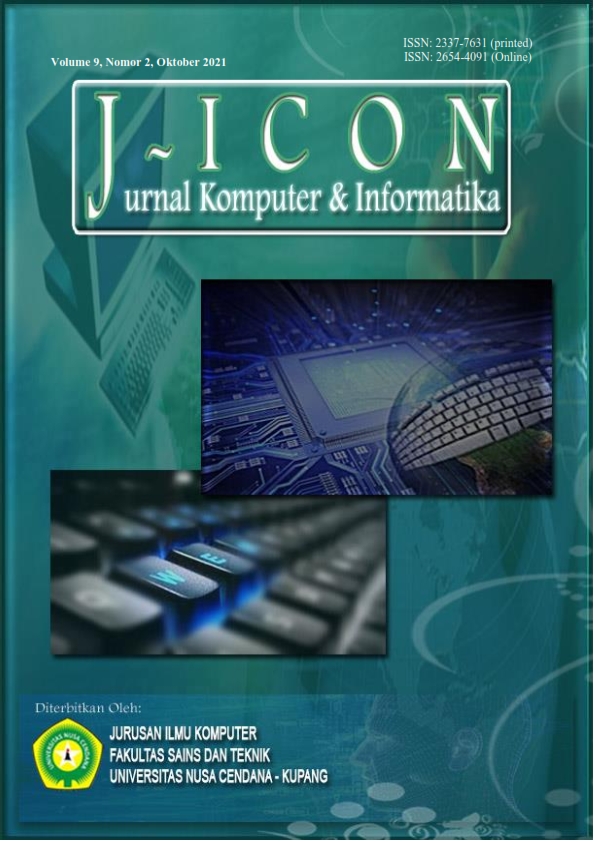GENERATING ENTITY RELATIONSHIP DIAGRAM FROM REQUIREMENT SPECIFICATION USING NATURAL LANGUAGE PROCESSING FOR INDONESIAN LANGUAGE
Abstract
Modeling an ERD can be done manually, but generally obtaining an Entity Relationship (ER) Diagram modeling manually will usually take a long time. So, it takes an ERD generator automation from the requirements specification to make it easier to do ERD modeling. This study will develop a system that produces ERD from requirements specifications in Indonesian by applying several stages of Natural Language Processing (NLP) according to needs research. The requirements specification used by the research team used technical document analysis. The stages of NLP used by the research team are: case folding, sentence segmentation, tokenization, POS tagging, chunking and parsing. Then the research team will conduct the words from the text that have been studied in the stages of NLP with the Rule-Based method to find a list of words that meet the ERD components such as: entities, attributes, primary keys and relations. The research team will describe the results obtained in the previous stage using the Graphviz library. From the results of the evaluation of the ERD system design, the research team used an expert evaluation evaluation. From the evaluation results obtained based on the evaluation of several cases, the results of the average precision, recall, and F1 scores from each expert are: 91%, 90%, 90% in expert 1; in expert 2 obtained 90%, 90%, 90%; in expert 3 obtained 98%, 94%, 96%; in expert 4 obtained 93%, 93%, 93%; and in expert 5 obtained 98%, 83%, 90%.
Downloads
References
P. G. T. H. Kashmira and S. Sumathipala, “Generating Entity Relationship Diagram from Requirement Specification based on NLP,” 2018 3rd Int. Conf. Inf. Technol. Res. ICITR 2018, pp. 1–4, 2018, doi: 10.1109/ICITR.2018.8736146.
S. Ghosh, R. Bashar, P. Mukherjee, and B. Chakraborty, “Automated generation of e-r diagram from a given text in natural language,” Proc. - Int. Conf. Mach. Learn. Data Eng. iCMLDE 2018, pp. 97–102, 2019, doi: 10.1109/iCMLDE.2018.00026.
E. S. Btoush and M. M. Hammad, “Generating ER Diagrams from Requirement Specifications Based On Natural Language Processing,” Int. J. Database Theory Appl., vol. XIII, no. 2, pp. 61–70, 2015, doi: 10.14257/ijdta.2015.8.2.07.
M. K. Habib, “On the Automated Entity-Relationship and Schema Design by Natural Language Processing,” Int. J. Eng. Sci., vol. VIII, no. 11, pp. 42–48, 2019, doi: 10.9790/1813-0811034248.
“Penduduk Indonesia,” 2012. https://www.bps.go.id/publication/2012/05/23/9cd01b5265c6988245eca87a/migrasi-internal-penduduk-indonesia-hasil-sensus-penduduk-2010.
M. L. A. Latukolan, A. Arwan, and M. T. Ananta, “Pengembangan Sistem Pemetaan Otomatis Entity Relationship Diagram Ke Dalam Database,” J. Pengemb. Teknol. Inf. dan Ilmu Komput., vol. III, no. 4, pp. 4058–4065, 2019, [Online]. Available: http://j-ptiik.ub.ac.id/index.php/j-ptiik/article/view/5117.
A. S. H. F. K. S. Sudarshan, Database System Concepts, 6th ed. United States: Raghothaman Srinivasan, 2011.
Y. A. Pratama and E. Junianto, “Sistem Pakar Diagnosa Penyakit Ginjal Dan Saluran Kemih Dengan Metode Breadth First Search,” J. Inform., vol. II, no. 1, 2015, doi: 10.31311/ji.v2i1.69.
A. Munif, Basis Data. Jakarta, 2013.
E. Darmanto, “Analisa Perbandingan Pemodelan Basis Data Menggunakan Er- Diagram Dan Eer-Diagram Pada Kasus Sistem Asistensi Perkuliahan Praktikum,” Simetris J. Tek. Mesin, Elektro dan Ilmu Komput., vol. VII, no. 1, p. 405, 2016, doi: 10.24176/simet.v7i1.532.
D. S. Indraloka and B. Santosa, “Penerapan Text Mining untuk Melakukan Clustering Data Tweet Shopee Indonesia,” J. Sains dan Seni ITS, vol. VI, no. 2, pp. 6–11, 2017, doi: 10.12962/j23373520.v6i2.24419.
D. Jurafsky and J. H. Martin, Speech and Language Processing: An introduction to natural language processing, Third Edit. New Jersey: Prentice Hall, 2020.
K. Widhiyanti and A. Harjoko, “POS Tagging Bahasa IndonesiaDengan HMM dan Rule Based,” Informatika, vol. VIII, no. 2, 2012.
I. F. Rozi, “Implementasi Rule-Based Document Subjectivity Pada Sistem Opinion Mining,” ELTEK, vol. XI, no. 1, pp. 29–41, 2013.
A. W. Syahroni and Harsono, “Aplikasi Penentuan Kategori dan Fungsi Sintaksis Kalimat Bahasa Indonesia,” InfoTekJar J. Nas. Inform. dan Teknol. Jar., vol. I, no. 1, 2019.
Y. Setyawan, “VISUALISASI GRAF DAN ALGORITMA-ALGORITMA DALAM TEORI GRAF MENGGUNAKAN BEBERAPA PAKET SOFTWARE,” SNAST, no. November, pp. 211–216, 2014.
Copyright (c) 2021 J-Icon : Jurnal Komputer dan Informatika

This work is licensed under a Creative Commons Attribution 4.0 International License.
The author submitting the manuscript must understand and agree that if accepted for publication, authors retain copyright and grant the journal right of first publication with the work simultaneously licensed under a Creative Commons Attribution (CC-BY) 4.0 License that allows others to share the work with an acknowledgment of the work’s authorship and initial publication in this journal.
 Parmonangan R. Togatorop(1*)
Parmonangan R. Togatorop(1*)




